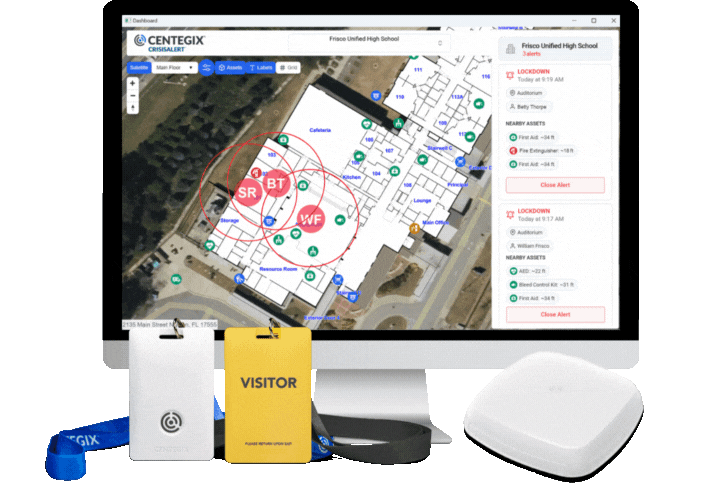Many school districts across the US are pursuing more equitable practices in hiring, resource allocation, and teaching practices. A growing understanding of the wide variety of student needs and reasons for disparities has motivated school districts to establish new, more equitable policies. Educational equity ensures that schools offer equal opportunities for learning. This does not mean that every student receives precisely the same resources. Rather, “additional resources should be distributed to students with the greatest needs. When thinking about equitable distribution of resources, it is important to understand that equitable does not mean equal.” As school districts work to accomplish equity on their campuses, consideration should be given to individual students’ backgrounds, experiences, and unique challenges, and ensure resources are distributed accordingly. A school alert system with a wearable emergency button is a safety resource that can provide valuable data to support equity on school campuses. Education experts point to several core elements of educational equity. When these components become an embedded part of district practice, they support an environment that lends itself to more equitable discussions, decisions, and actions. These components are
- vision
- understanding
- action
- engagement
- accountability
Each of these components focuses on involving the community in defining, working toward, and benefiting from more equitable policies. School districts do not gift educational equity to their students and families, but rather build equitable systems with their communities.
Contributors to Inequitable Distribution of Resources

School Alert System Data Collection Aids in Equitable Resource Allocation
Many factors contribute to the inequitable distribution of educational resources. These include school district size, individual school size, community socioeconomic conditions, and school community demographics. Students routinely receive dramatically different learning opportunities based on their socioeconomic status, despite the rhetoric of American equality. In other words, the “school experiences” of African-American and other minority students in the United States continue to be substantially separate and unequal.” As a consequence of systematic inequalities, minority and low-income students are frequently at risk, not from their homes or family factors, but from the major shortcomings of the schools they attend. The presumption that the problem is with the children rather than the educational system is flawed; in fact, the educational status quo places children at risk of underachievement and a host of other challenges throughout their lifetimes. According to the Brookings Institution, “educational outcomes for minority children are much more a function of their unequal access to key educational resources, including skilled teachers and quality curriculum than they are a function of race.”
How Traditional Funding Formulas Create Disparities
These disparities are both caused and exacerbated by traditional school funding mechanisms. Public education is primarily funded by state and local tax dollars. While every state has a funding formula codifying some mechanism for equalizing revenue across school districts, most states don’t provide equal access to resources to low-income students. Affluent communities can more easily tap into their tax bases to raise additional dollars, which can lead to gaping inequities that too often shortchange students of color. Research sponsored by the National Institutes of Health shows that districts and schools with higher proportions of low-income and minority students are allocated fewer fiscal and educational resources than more affluent ones, despite the probability that these students have a substantially greater need for both. While no single factor creates the stark achievement gaps observed in American schools, inequality in public school funding certainly contributes. Addressing the unfortunate disparities in public education requires taking a hard look at gaps in funding and creating solutions that ensure US public education allows all students to reach their full potential.
The Pathway to Educational Equity with School Alert Systems
Inequities in education are not inevitable. States and districts can adopt policies that distribute money in ways that alleviate inequality in public school funding and level the playing field. Concerns about educational equity have resulted in many school districts seeking to turn around outmoded resource allocation practices. This means careful consideration of where to allocate funds. But resources include a range of elements beyond funding:
- staff expertise, talent, and time
- student learning time
- outside services offered by community partners
Effective resource allocation strategies are concerned not with per-pupil quantity of investments but with the quality and variety of existing investments in people and programs. This way of thinking contributes to a culture shift wherein schools seek to establish a systemwide, collaborative culture. This school culture has high academic expectations and is committed to supporting students in their academic achievement and social-emotional well-being. Student-based allocation (SBA) formulas seek to ensure equitable distribution of qualified teachers and other resources across districts. When using an SBA formula, districts allocate funding based on the needs of designated student types within a school. Districts can thereby better match a school’s resources to a school’s needs based on the mix of students in the building. Even in districts that use these formulas, however, allocation resource practices are often ingrained, which can make allocations less equitable and transparent. Applying the core elements of educational equity is a powerful tool to assist districts in thinking about equitable resource allocation in fresh new ways. Research shows that a more equitable distribution of teachers has positive effects on student outcomes. The presence of qualified teachers is centrally important to learning, as proven by real-world examples of districts in which qualified teachers were distributed equally throughout the district. The distribution of qualified teachers across districts is centrally important to student learning.
Data Collection and Analysis Enables Equitable Resource Allocation

School Alert System Data Collection Aids in Equitable Resource Allocation
The Every Student Succeeds Act (ESSA) requires that schools “advance equity by upholding critical protections for America’s disadvantaged and high-need students.” The federal law also “maintains an expectation that there will be accountability and action to effect positive change in our lowest-performing schools, where groups of students are not making progress, and where graduation rates are low over extended periods of time.” In order to meet this expectation, educational leaders must be concerned not only with the level of resources and how they are distributed across districts, schools, and classrooms but also with how these investments translate into improved learning. Districts must be able to uncover inequities in their own resource allocation in order to ensure that their policies contribute to these improvements. Data collection allows districts insight into their allocation policies and systems. Schools must employ effective resource management strategies in order to effectively distribute funding and resources. Resource management is the process of allocating resources to achieve the most significant organizational value. To undertake this process in a way that is compatible with ESSA, school districts need to understand where resources are most needed, and where bias prevents equitable allocation of these resources.
CrisisAlert School Alert System Facilitates Data Collection
To determine whether certain resources benefit students and if those benefits justify the cost, administrators can collect and analyze data. By keeping track of the number, type, and location of alerts, the CENTEGIX CrisisAlert school alert system provides a data set for administrators to analyze. By doing so, school leaders can better understand if and how bias plays into teacher decisions to initiate an alert. The data set also illuminates what needs are greatest at all levels, from individual classrooms to the entire campus. By responding to these specific requirements, schools can meet teachers’ and students’ everyday needs, and ensure the equitable allocation of resources. The CENTEGIX CrisisAlert system includes a dashboard that tracks the types of alerts initiated throughout campus on a daily, weekly, or monthly basis. Tracking this data helps administrators to identify which and how many staff members request intervention. The data set also reveals what areas of expertise staff members possess, and indicates what tangible resources are needed. An overview of this data allows administrators to allocate resources equitably, by directing them where they are most needed. These resources may include school nurse support, additional paraprofessional assistance in a classroom, or additional monitors in one hallway on campus, for example. The CENTEGIX CrisisAlert school alert system is a valuable resource for schools as they seek to better understand where resources are needed and distribute them accordingly. CrisisAlert data allows districts and schools to make highly informed decisions about student and teacher wellness while simultaneously improving student and staff safety on campus. CENTEGIX is the leader in incident response solutions. Our CrisisAlert platform is the fastest and easiest way for staff to call for help in any emergency, from the everyday to the extreme. CENTEGIX creates safer spaces by innovating technology to empower and protect people, and leaders nationwide trust our safety solutions to provide peace of mind. To learn more about CENTEGIX, visit www.centegix.com.










